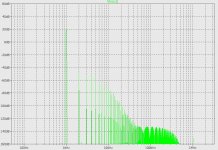Long time no hear. Hope all is fine.
Patrick
Hello my friend.
I should be back for a while now.
Very happy to help you with anything
If you are still interested in building the F5X, just drop me a mail.
We'll see what can be arranged.
Patrick
We'll see what can be arranged.
Patrick
Just word of warning Nelson.
You better be going to work early and staying back late everyday over next few weeks.
Something is in the mail.
😀
You better be going to work early and staying back late everyday over next few weeks.
Something is in the mail.
😀
Yes, 15V peak, not peak-to-peak, into 3 ohms.Did you perform your simulation with 15V Peak on a 3 Ohm load ?
Post your results.
Do you have a model for MUR3020 ?
I could not find a model for the MUR3020, but used the MUR2020 instead. That could be the problem. Can you provide a Spice mode for the MUR3020?
.MODEL MUR3020wt D(IS=2.09832e-06 RS=0.0102995 N=2 EG=1.27539 XTI=0.5 BV=200 IBV=1e-05 CJO=1.14907e-09 VJ=0.4 M=0.888092 FC=0.5 TT=7.76886e-08 KF=0 AF=1)
.MODEL MUR3020wt D(IS=2.09832e-06 RS=0.0102995 N=2 EG=1.27539 XTI=0.5 BV=200 IBV=1e-05 CJO=1.14907e-09 VJ=0.4 M=0.888092 FC=0.5 TT=7.76886e-08 KF=0 AF=1)
Thanks for the Spice model. I now get THD plots very similar to yours. The main difference is that my 2nd harmonic is higher than yours in both cases. Could be due to differences in Spice models for the IRFP240/IRFP9240 MOSFETs, or slight differences in biasing. My biasing looks good: it required careful adjustment to get 15 V peak without leaving class-A.
Attachments
Something just occurred to me about the circuit.
I think it is capable of even better performance, just need to wait till tomorrow to confirm it.
I think it is capable of even better performance, just need to wait till tomorrow to confirm it.
Something just occurred to me about the circuit.
I think it is capable of even better performance, just need to wait till tomorrow to confirm it.
Before I saw your non-Turbo/Turbo THD plots and did some simulations, I was not convinced about the Turbo. EUVL has proposed an alternative based on reducing the source resistors to near zero, which helps, but increases the problem of bias current vs. temperature.
I am now a believer in the Turbo.
Hehehehehehe
If my hunch is right, I will be very happy.
Nelson is very sly.
I feel dumb again (as usual) for not thinking of this immediately.
Very basic stuff. Not rocket science.
Bloody brilliant though
If my hunch is right, I will be very happy.
Nelson is very sly.
I feel dumb again (as usual) for not thinking of this immediately.
Very basic stuff. Not rocket science.
Bloody brilliant though
Last edited:
Hehehehehehe
If my hunch is right, I will be very happy.
Nelson is very sly.
I feel dumb again (as usual) for not thinking of this immediately.
Very basic stuff. Not rocket science.
Bloody brilliant though
My hunch was right. Although the improvement is only subtly better than the original diode results posted earlier.
You are misquoting me I am afraid.
My proposed alternative (in post #42) is not based on reducing the source resistor (only).
The key to my proposal is using MOSFETs with much higher Yfs (e.g. 2SK3497).
That, combined with a reduction in Rsource will give the same current gain as a 2SK1530 plus a diode.
See :
http://www.diyaudio.com/forums/pass-labs/206240-f5-turbo-posted.html#post2896992
And I do not consider 0R33 for Rsource to be low. The F5X uses 0R22 since day one.
Nor have I ever experienced any bias stability at steady state.
Yes, the bias is a bit lower when cold. But once it has warmed up, it stays there.
Assuming of course your heat sinks are properly sized.
And I am still not a believer of the diode.
Patrick
My proposed alternative (in post #42) is not based on reducing the source resistor (only).
The key to my proposal is using MOSFETs with much higher Yfs (e.g. 2SK3497).
That, combined with a reduction in Rsource will give the same current gain as a 2SK1530 plus a diode.
See :
http://www.diyaudio.com/forums/pass-labs/206240-f5-turbo-posted.html#post2896992
And I do not consider 0R33 for Rsource to be low. The F5X uses 0R22 since day one.
Nor have I ever experienced any bias stability at steady state.
Yes, the bias is a bit lower when cold. But once it has warmed up, it stays there.
Assuming of course your heat sinks are properly sized.
And I am still not a believer of the diode.
Patrick
Last edited:
Patrick it is very quick and easy to wire a diode into your circuit.
Probably take all of 30 minutes to try it and if you don't like the results take it out.
Just try it.
Probably take all of 30 minutes to try it and if you don't like the results take it out.
Just try it.
Simply adding in a parallel diode to the source resistor is not advised.
I have asked a few times what is the set up procedure to give the diode version of the F5 a real chance to perform well. To date I seem to be the only one answering myself.
I still have to write up partIII.
I have asked a few times what is the set up procedure to give the diode version of the F5 a real chance to perform well. To date I seem to be the only one answering myself.
I still have to write up partIII.
- Status
- Not open for further replies.
- Home
- Amplifiers
- Pass Labs
- F5 Turbo is posted

